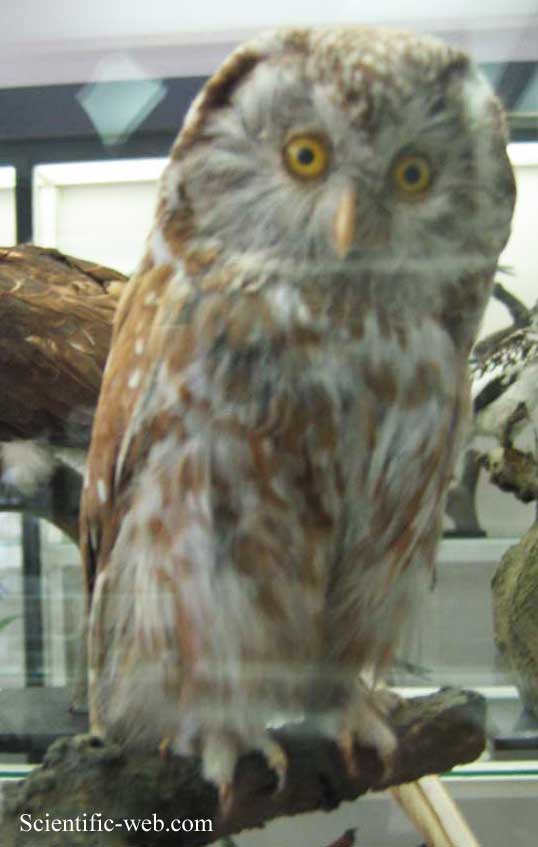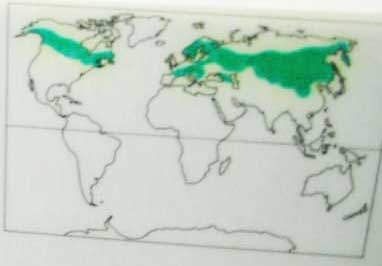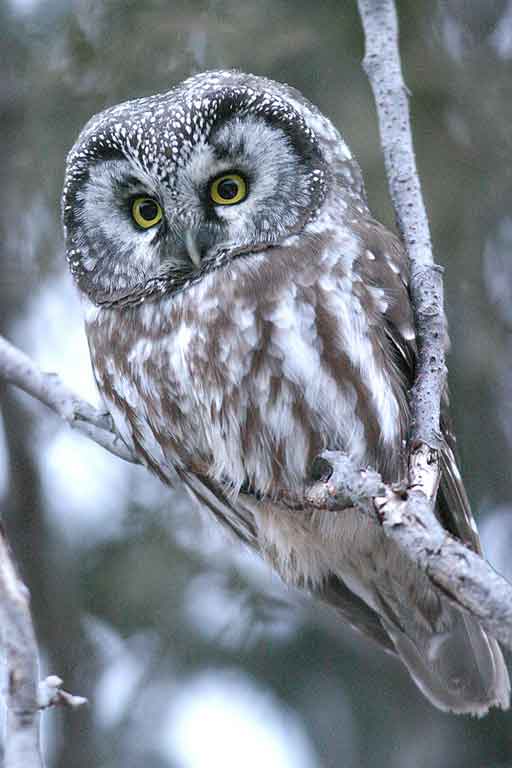
Aegolius funereus, Photo: Michael Lahanas
Superregnum: Eukaryota
Regnum: Animalia
Subregnum: Eumetazoa
Cladus: Bilateria
Cladus: Nephrozoa
Superphylum: Deuterostomia
Phylum: Chordata
Cladus: Craniata
Subphylum: Vertebrata
Infraphylum: Gnathostomata
Superclassis: Tetrapoda
Cladus: Reptiliomorpha
Cladus: Amniota
Classis: Reptilia
Cladus: Eureptilia
Cladus: Romeriida
Subclassis: Diapsida
Cladus: Sauria
Infraclassis: Archosauromorpha
Cladus: Crurotarsi
Divisio: Archosauria
Subsectio: Ornithodira
Subtaxon: Dinosauromorpha
Cladus: Dinosauria
Ordo: Saurischia
Cladus: Theropoda
Cladus: Neotheropoda
Infraclassis: Aves
Cladus: Euavialae
Cladus: Avebrevicauda
Cladus: Pygostylia
Cladus: Ornithothoraces
Cladus: Euornithes
Cladus: Ornithuromorpha
Cladus: Ornithurae
Cladus: Carinatae
Parvclassis: Neornithes
Cohors: Neognathae
Ordo: Strigiformes
Familia: Strigidae
Subfamilia: Surniinae
Genus: Aegolius
Species: Aegolius funereus
Subspecies: A. f. beickianus – A. f. caucasicus – A. f. funereus – A. f. magnus – A. f. pallens – A. f. richardsoni – A. f. sibiricus
Name
Aegolius funereus (Linnaeus, 1758)
Synonymy
Strix funerea (protonym)
References
Linnaeus, C. 1758. Systema Naturae per regna tria naturæ, secundum classes, ordines, genera, species, cum characteribus, differentiis, synonymis, locis, Tomus I. Editio decima, reformata. Holmiæ: impensis direct. Laurentii Salvii. i–ii, 1–824 pp DOI: 10.5962/bhl.title.542: 93.
Vernacular names
العربية: البومة الصغيرة قبسة، بومة
asturianu: Curuxa de Tengmalm
azərbaycanca: Qütb bayquşu
беларуская: Касматаногі сыч
български: Пернатонога кукумявка
brezhoneg: Kaouenn-dTengmalm
català: Mussol pirinenc
čeština: Sýc rousný
Чӑвашла: Тĕклĕ уралла тăмана
Cymraeg: Tylluan Tengmalm
dansk: Perleugle
Deutsch: Raufußkauz
Ελληνικά: Αιγωλιός
English: Tengmalm's Owl
Esperanto: Funebra strigo
español: Lechuza boreal
eesti: Karvasjalg-kakk
euskara: Mussol pirinenc
suomi: Helmipöllö
føroyskt: Hjómut ugla
français: Chouette de Tengmalm
galego: Moucho de Tengmalm
עברית: כוס חום
hrvatski: Mrtvačka sovica
magyar: Gatyáskuvik
հայերեն: Բու թավշաոտ
íslenska: Skálmugla
italiano: Civetta capogrosso
日本語: キンメフクロウ(金目梟)
ქართული: ბუკიოტი
қазақша: Орман байғызы
lietuvių: Lututė
latviešu: Bikšainais apogs
македонски: Јакеста кукумјавка
монгол: Савагт ууль
Bahasa Melayu: Burung hantu telinga pendek
Nederlands: Ruigpootuil
norsk nynorsk: Perleugle
norsk: Perleugle
polski: Włochatka
português do Brasil: Mocho-dos-banhados
português: Mocho de Tengmalm
rumantsch: Tschuetta pailusa
русский: Мохноногий сыч
davvisámegiella: Bearalskuolfi
slovenčina: Pôtik kapcavý
slovenščina: Koconogi čuk
shqip: Kukuvajka e Tengmalnit
српски / srpski: Gacasta kukumavka - Гачаста кукумавка
svenska: Pärluggla
Türkçe: Paçalı baykuş
українська: Сич волохатий
中文: 鬼鴞
The boreal owl or Tengmalm's owl (Aegolius funereus) is a small owl. It is known as boreal owl in North America, and in Europe typically as Tengmalm's owl after Swedish naturalist Peter Gustaf Tengmalm or, more rarely, Richardson's owl after Sir John Richardson.[2][3] The scientific name is from Latin. The genus name Aegolius is a type of screech owl, and funereus means "funereal".[4]
This species is a part of the larger grouping of owls known as Strigidae (true owl), which contains the most species of owl. The other grouping is Tytonidae (barn owl).
Due to the boreal owl's shyness and evasive reaction to human activities, nocturnal habits and preferred inaccessible taiga forest habitat, it is rarely seen by humans.
Description
Juvenile at Innsbruck Zoo
The boreal owl is 22–27 cm (8.7–10.6 in) long with a 50–62 cm (20–24 in) wingspan. The boreal owl has a weight range of 3.3–7.6 oz (94–215 g).[5] It is brown above, with white flecking on the shoulders and whitish underparts with rust-colored streaks. (The plumage of young birds is chocolate brown.) Its head is large with yellow eyes and a white facial disc that is sometimes described as giving the owl a "surprised" expression. The beak is a light yellow, rather than dark like its relative the northern saw-whet owl.[6] The boreal owl's flight is relatively noiseless and straight.[7]
Behaviour
The boreal owl is an unsociable nocturnal owl.[8] Its call is similar in sound to the "winnowing" of the North American Wilson's snipe.[9][10] This species is not normally migratory, but in some autumns significant numbers move further south. It is rarely any great distance south of its breeding range, although this is partly due to the problems of detecting this nocturnal owl outside the breeding season when it is not calling.
Breeding
Egg, Collection Museum Wiesbaden
The boreal owl breeds in dense coniferous forests across northern North America and the Palearctic, and in mountain ranges such as the Alps and the Rockies. It lays 3–6 eggs in a tree hole. Across much of Europe, and to a lesser extent in Asia and North America, naturalists and biologists put up nest boxes for these and other small owls.
Feeding and diet
This small owl eats mainly voles and other mammals but also birds as well as insects and other invertebrates. It is largely nocturnal, though in the northernmost parts of its range, it has to hunt during daylight because of the very short nights in summer.
Mortality
Banded boreal owls have been known to live up to 16 years. Due to the owl's small stature it is often eaten by other owls and large raptors thus decreasing its average life span.
Subspecies
Boreal owls have seven subspecies:[11]
A.f funereus (Linnaeus, 1758): nominate subspecies, from Scandinavia down south to the Pyrenees and east to the Urals, but not the Caucasus Mountains
A.f. richardsoni (Bonaparte, 1838): the North American subspecies, from Alaska down the Rocky Mountains and as far east as Southeastern Canada and the Northeast US
A.f. pallens (Schalow, 1908): from southeastern Siberia to Tien Shan in China
A.f. caucasicus (Buturlin, 1907): Caucasus Mountains
A.f. magnus (Buturlin, 1907): from Eastern Siberia from Kolyma to the Kamchatka peninsula
A.f. sibiricus (Buturlin, 1910): widespread over Siberia
A.f. beickianus Stresemann, 1928: from Northwest India to western China
References
BirdLife International (2012). "Aegolius funereus". IUCN Red List of Threatened Species. 2012. Retrieved 26 November 2013.
"Aegolius funereus". Avibase.
Beolens, Bo; Watkins, Michael (2003). Whose bird?: Men and women commemorated in the common names of birds. London: Helm. ISBN 0713666471.
Jobling, James A (2010). The Helm Dictionary of Scientific Bird Names. London: Christopher Helm. pp. 33, 166. ISBN 978-1-4081-2501-4.
"Boreal Owl Identification, All About Birds, Cornell Lab of Ornithology". www.allaboutbirds.org. Retrieved 2020-09-26.
Bull, Farrand (1994). National Audubon Society Field Guide to North American Birds: Eastern Region. New York: Alfred A. Knopf. p. 554. ISBN 0-679-42852-6.
[1], page 442
"The Owl Pages". Retrieved May 10, 2013.
Alaska Department of Fish and Game The Boreal Owl. [2], Retrieved on May 10, 2013.
"Boulder County Nature Association". Retrieved May 10, 2013.
Gill F & D Donsker (Eds). 2014. IOC World Bird List (v 4.2). doi:10.14344/IOC.ML.4.2 www.worldbirdnames.org Accessed 25 May 2014.
Retrieved from "http://en.wikipedia.org/"
All text is available under the terms of the GNU Free Documentation License



